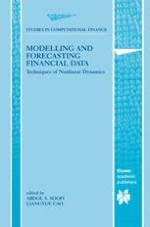2002 | OriginalPaper | Buchkapitel
Surrogate Data Test on Time Series
verfasst von : D. Kugiumtzis
Erschienen in: Modelling and Forecasting Financial Data
Verlag: Springer US
Enthalten in: Professional Book Archive
Aktivieren Sie unsere intelligente Suche, um passende Fachinhalte oder Patente zu finden.
Wählen Sie Textabschnitte aus um mit Künstlicher Intelligenz passenden Patente zu finden. powered by
Markieren Sie Textabschnitte, um KI-gestützt weitere passende Inhalte zu finden. powered by
Given a real random-like time series, the first question to answer is whether the data carry any information over time, i.e. whether the successive samples are correlated. Using standard statistical testing, the least interesting null hypothesis of white noise has to be rejected if the analysis of the time series should be of any use at all. Further, if nonlinear methods are to be used, e.g. a sophisticated nonlinear prediction method instead of a linear autoregressive model, the null hypothesis to be rejected is that the data involve only temporal linear correlations and are otherwise random. A statistically rigorous framework for such tests is provided by the method of surrogate data. The surrogate data, generated to represent the null hypothesis, are compared to the original data under a nonlinear discriminating statistic in order to reject or approve the null hypothesis.The surrogate data test for nonlinearity has become popular in the last years, especially with regard to the null hypothesis that the examined time series is generated by a Gaussian (linear) process undergoing a possibly nonlinear static transform. Properly designed surrogate data for this null hypothesis should possess the same autocorrelation and amplitude distribution as the original data and be otherwise random. However, the algorithms do not always provide surrogate data that preserve the original linear correlations, and this can lead to false rejections. The rejection of the null hypothesis may also depend on the applied nonlinear method and the choice of the method’s parameters. Also, different observed time series from the same system may give different test results.This chapter will describe the surrogate data test for the two hypotheses, i.e. white noise data and linear stochastic data. For the latter, some of the limitations and caveats of the test will be discussed and techniques to improve the robustness and reliability of the test will be reviewed. Finally, the tests will be applied to some financial data sets.
